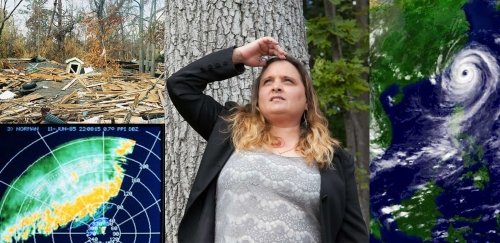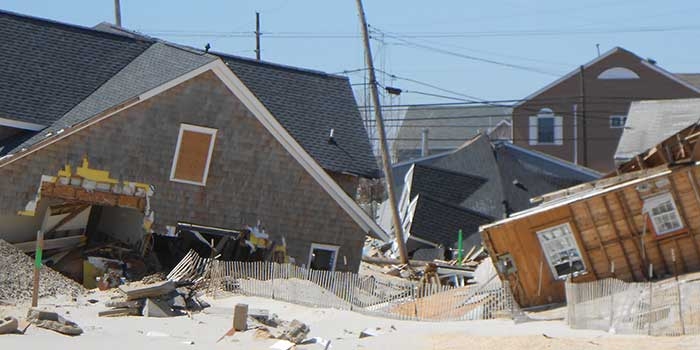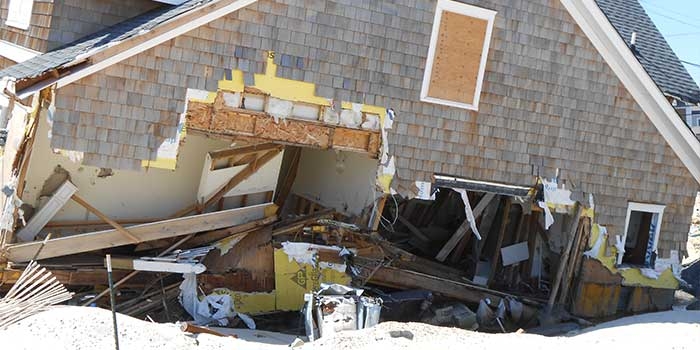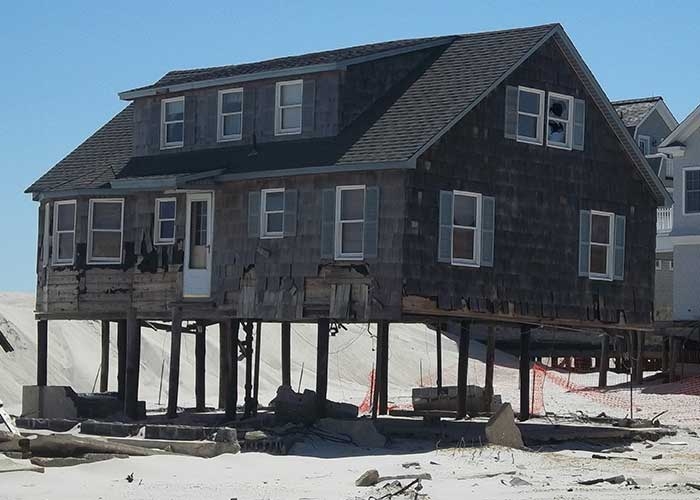Born on the Tail of a Hurricane: RIC Adjunct Jennifer Bonin
- News & Events
- News
- Born on the Tail of a Hurricane: RIC Adjunct Jennifer Bonin

“I was born during Hurricane Agnes, one of New England’s earliest land-falling hurricanes. It seems hurricanes have been following me ever since,” says RIC Adjunct Instructor of Geography Jennifer Bonin ’04.
Since 2005 RIC Adjunct Instructor of Geography Jennifer Bonin ’04 has been on the site of every land-falling hurricane in the United States: Rita (2005), Wilma (2005), Katrina (2005), Gustav (2008), Ike (2008), Irene (2011), Isaac (2012) and Sandy (2012).
At barely five feet tall, Bonin is somewhat of a mini hurricane herself – charged with energy, restless, changing the course of a conversation as quickly as a hurricane changes direction. In this article, she takes you into the world of hurricanes and her work in disaster management.
“There are three things that have to be present for a hurricane to form,” Bonin said. “Water has to be above 80 degrees, upper-level winds have to be favorable and a combination of atmospheric moisture and heat must generate enough energy to propel a hurricane. The longer a hurricane has warm water and favorable winds, the stronger it will become.”
Disaster management is one of the courses Bonin teaches at RIC, along with GIS (geographic information system) and coastal geography. She was also employed by Halliwell Engineering Associates in East Providence as a GIS specialist and disaster analyst, providing daily mapping of Federal Emergency Management Agency (FEMA) flood insurance zones, along with meteorological research and analyses, which she described as a type of “crime scene investigation.”
Following Hurricane Sandy, Bonin was sent, along with Halliwell’s engineers, to New Jersey to assess the damage.
“The engineers would assess what Mother Nature had done, and I would tell them how she did it and put it on a map,” Bonin explained. “New Jersey is lined with islands to protect the mainland from storm surge. It was these sandbars that were hit by Sandy and not the state of New Jersey. Yet the islands are also very densely populated with vacation homes. Being October, many of the homes were empty at the time the hurricane hit,” she said.
On one trip to the Jersey shore, Bonin brought a group of RIC honor students along with her. “They had never witnessed damage to that extent,” she said, “and they were awed.”



As a RIC alumna, Bonin takes pride in RIC’s Department of Geography, which she described as having “passionate professors and very dedicated students. Professors Mark Motte and Stanford Demars groomed me to do the work that I am doing,” she said.
Bonin also volunteers at the Providence Emergency Management Agency and Office of Homeland Security – a central command and control facility that carries out emergency management during threatened or actual natural disasters, acts of terrorism or manmade disasters. She has received commendations from the mayor of Providence for her work with the agency.
“I go where I’m needed,” she said. “I don’t want disasters to happen, but if they do, I want to be there front row and center, because I have a skill that can help people.“
Bonin was deployed to New Orleans to assist with emergency operations following Hurricane Katrina. Once there, she quickly realized that she was more needed in Mississippi.
“What many people don’t realize is that Hurricane Katrina made landfall not in New Orleans but in neighboring Waveland, Mississippi. A 30-foot-high storm surge devastated the entire Mississippi coastline and hundreds of miles inland. Half of Mississippi was destroyed. New Orleans was severely hit by the subsequent flood water the next day.”
Bonin volunteered her services to the fire department in Bay St. Louis, Mississippi, conducting research and creating computerized maps for the towns of Bay St. Louis, Waveland and Gulfport.
She described Bay St. Louis as a fallout zone, where much of the city had been leveled. While standing in the rubble as firemen recovered bodies, she saw dogs and cats hanging from trees. She said, “Some of the animals had been left in homes where a 30-foot-high surge had flooded the interiors of the homes and where winds had blown the buildings apart. The animals basically drowned inside.”
Though Bonin has witnessed the devastation wrought by major storms – felled trees, property damage, power outages – she said Katrina changed her life. “Katrina’s destruction was on such a massive scale,” she said.
Bonin returned to both New Orleans and Bay St. Louis six months later only to find that “little had changed.” “There was still the same level of destruction,” she said. “Houses were still on top of cars. They were still finding bodies.”
Disaster planning and disaster management at the federal, state and local levels are critical, she said.
Could Katrina happen again? “Governments change, management changes, priorities change,” she said. “Disaster management has to be made a priority at all levels of government.”
